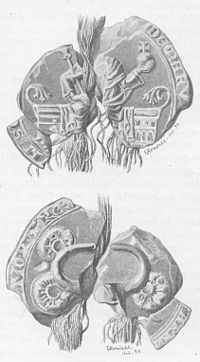Valdemar III
| Valdemar III | |||||
|---|---|---|---|---|---|

Seal of Valdemar III
|
|||||
| King of Denmark | |||||
| Reign | 1326–1330 | ||||
| Predecessor | Christopher II and Eric Christoffersen | ||||
| Successor | Christopher II and Eric Christoffersen | ||||
| Regent | Gerhard of Holstein | ||||
| Duke of Schleswig | |||||
| Reign | 1325–1326 1330–1364 |
||||
| Predecessor |
Eric II Gerhard of Holstein |
||||
| Successor |
Gerhard of Holstein Henry |
||||
| Born | 1314 | ||||
| Died | 1364 | ||||
| Consort | Richardis of Schwerin | ||||
| Issue | Valdemar, Hereditary Prince of Schleswig Henry, Duke of Schleswig |
||||
|
|||||
| House | Estridsen (Abelslægten line) | ||||
| Father | Eric II, Duke of Schleswig | ||||
| Mother | Adelaide of Holstein-Rendsburg | ||||
| Religion | Roman Catholicism | ||||
| Full name | |
|---|---|
| Valdemar Eriksen |
Valdemar III (1314–1364) was king of Denmark from 1326 to 1329, while he was underage; he was also Duke of Schleswig as Valdemar V in 1325–26 and from 1330 to 1364. He was a rival king set up against the unsuccessful Christopher II and was widely opposed by his subjects. His term was ended when he abdicated. Sometimes the earlier king Valdemar the Young is called Valdemar III instead.
Valdemar's father was Duke Eric II of Schleswig and his mother was Adelaide, daughter of Henry I of Rendsborg.
When his distant kinsman and the head of the rival royal branch Christopher II of Denmark was exiled from his kingdom, the Holsteiner and Danish high nobles got to choose a new king. Their choice fell to 11-year-old Duke Valdemar V of Schleswig, who was the head of the branch descended from king Abel of Denmark. Due to his young age, his maternal uncle, the mighty Count Gerhard of Rendsborg (Gerhard III of Holstein) who also was the biggest pawnholder of mortgaged Denmark, was appointed as the Regent and guardian ("grev Gert" or "Den kullede Greve").
Valdemar's ascension promissory was at least as strict as Christopher's had been. There were some new stipulations, such as all royal castles in Scania should be demolished, and all nobles received the right to fortify their homesteads. The most important agreement, however, was the so-called Constitutio Valdemariana, which promised that in the future, the same person could never be both ruler of Slesvig and Denmark simultaneously.
Valdemar accordingly gave up his patrimony, Schleswig, and enfeoffed it to his uncle and guardian, whereby the first Holsteinian became a Duke: Gerhard, Duke of Jutland (or Southern Jutland or Schleswig).
Denmark was now held totally by certain nobles, in practice. That was not popular among the peasants. A portion of the nobles were foreigners, and many set up new taxes. In 1328, peasants in Zealand rose in rebellion, though it was quelled, and a rebellion in Jutland followed in 1329; the Jutland rebellion had more success, but was also quelled in the end. Finally, count Gerhard gave up in the name of his king, and in 1329 Christopher II was allowed to return to the throne. Valdemar became again Duke of Schleswig.
...
Wikipedia
